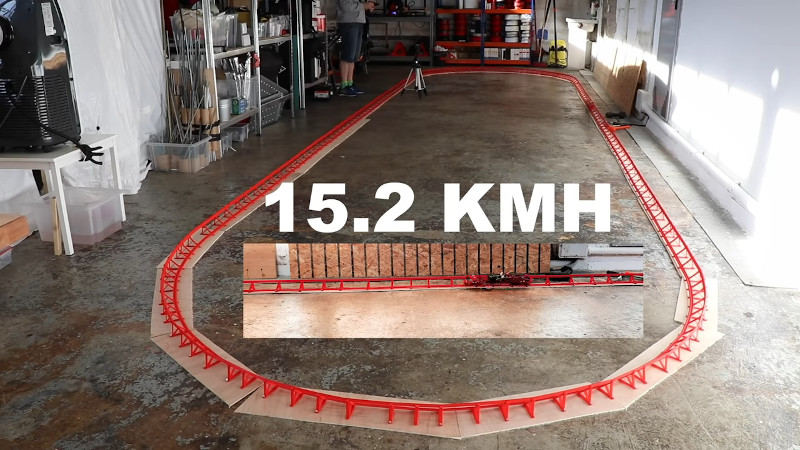For most involved in the hobby, model trains involve buying track from off-the-shelf suppliers, and lots of delicate painting and finishing. Conversely, [Ivan] just wanted to make something fast and fun, busting out the 3D printer in due course.
While the title of “World’s fastest toy train” is somewhat dubious, the build has its value as an interesting way of doing things. The train is 3D printed, with pressed-in ball bearings and metal shafts for the bogies. Differing from usual practice, this train carries its power supply on board, in the form of a LiPo battery. It’s hooked up to a brushless motor and controlled by a standard RC car setup.
The track is an impressive structure, consisting of 3D printed rails and supports. These are assembled and then screwed down to plywood baseplates, which are hot glued to the flat concrete floor of [Ivan]’s workshop. Strings were used to align everything as straight and true as possible. The track features a steep banking which helps with cornering. However, the straights remain banked in an effort to avoid the complex modelling of a transition. This leads to some derailments at higher speeds on the flat sections.
While it’s not yet perfect, [Ivan] has done a great job of demonstrating a quick and easy way to build a model railway out of almost entirely 3D printed components. We can’t wait to see improvements to the rails and railcars, and hope to see speeds increase significantly in future tests. 3D printing tends to bring some interesting results to bear on the model train world, such as this vertical hanging setup. Video after the break.
















Add a metal piece under the track and add magnets to the train.
Woulden’t the Eddy current slow it down?
Yes they would!
But a spoiler could work.
Because aerodynamic drag is free?
I have had 2 different toys that used magnets to keep on track and they were plenty fast. Slot cars, and a ho scale turbo train. So maybe it will take more power but if the limit is keeping on track, not power then it should help
Not if he makes it a wheeled rail gun!
I have to believe that RP-25 wheel contours and spiral easements would’ve been helpful here.
Easements for sure and probably the wheels as well – there are aspects to this that have already been well solved…
How fast would this translate to a full scale train, and what kind of G would it be pulling in the corners?
I like this guys level of being totally nuts.
Totally lame to close comments on the Fauci article. Not much negative was even said, but I guess the fear was the narrative might be compromised…
I was impressed that he reached “Senior Researcher” level in 6 years!
Well, we aren’t seeing the 10 comments still in the moderation queue that likely sent the discussion off the rails (sorry – had to link back to this train topic somehow).
Nice pun, but now I’ve got to get Ozzie’s song out of my head!
This is impressive.
But I’m very glad this guy doesn’t work for British rail. Imagine the fun if they’d decided to make things simpler by keeping a 45degree bank on straight sections…
“I’m sorry Madam, my tea will not stay in its cup!”
When British Rail did a tilting train, passengers complained their tea wouldn’t stay in their stomach. got queasy from it being slightly off (Tilting too soon and righting too late or something)
The Italian Pendolino train is like that, too.
It never works correctly and doesn’t quite match the tilt with the bends in the track, so you’re left with a rollercoaster mixed with a boat kind of feeling where, when you look out the windows, you see the sky on the right and the ground on the left, or vice versa, and it’s constantly shimmying and rocking slowly. If you don’t look out the windows, you’ll feel sick, and if you do look out the windows, it changes so much that you feel like you should be falling off your seat.
The end result was that they had to limit the tilt and run the train slower.
I’m pretty sure I read that the Pendolino’s are based on the technology of the APT – BR abandoned it, and sold it on; now we buy it back again.
This bothered me soooo much!
Flat head screwdriver?? The man is a glutton for punishment!
Lol my first thought exactly!
He should modify the track design and use “Roller coaster” wheels, it would never fly off then.
https://3dwarehouse.sketchup.com/model/1daad30257de95b4f388f5c8ec57c355/Roller-coaster-wheels?hl=en
And where’s the fun in that? Don’t you want to be hit by a 1Kg brick flying across the room towards you at 21Km/h?
Is this a 2 Gauge design?
This is actually great. We are creating toys from recycled plastic for demonstration purposes.
Here’s the project: https://medium.com/endless-filament/make-your-filament-at-home-for-cheap-6c908bb09922
Once you create filament, it’s easy to make anything from it.
3d printing is one area where recycling plastic does not have many problems.
Hats off to you. Very nice job. It inspires me.
Maybe add some more weight to it. It can’t have that much friction with those plastic wheels probably losing some speed to wheel spin.
I understand the easier design on the straight section by tilting it. It also get a easier design on the train itself as it do not need to twist.
But why not just keep the bend section only and remove the straight part?
Sure this would achieve faster speed! if all was curved.
I kinda feel like this is far too slow to really count as the fastest. Or maybe youth playing with slot cars distorts how fast I think it should go.
And… there’s a guinnes record at more than double the speed.
Bigger wheels / higher axles. Maybe also flatten out the track in the straights.
Amazing – someone out there still uses flathead screwdrivers for doing up screws.